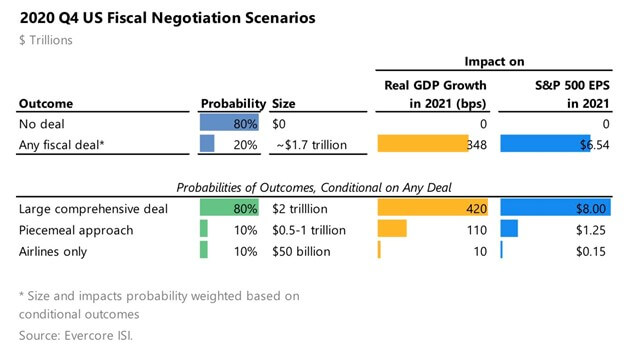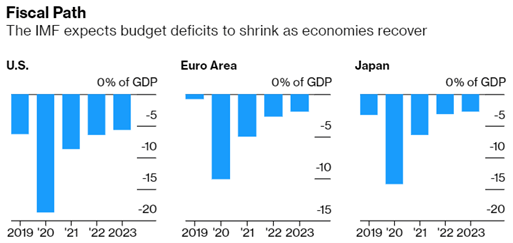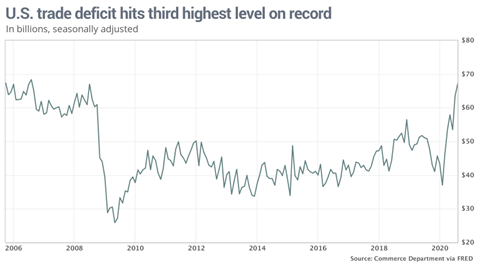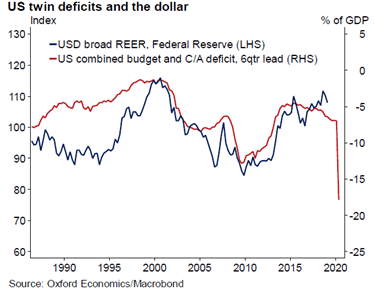The Full Story:
Markets have begun looking past the election.
A Trump victory means another dose of stimulus and a return to the pre-COVID economy which, quite frankly, was working very well for all Americans. A Biden victory means an even larger stimulus followed by the potential for higher taxes and tighter regulations.
While this may act as a tax on earnings and investor returns somewhere off in the distance, those policies require a “blue wave”, followed by a legislation and adoption period. That’s a story for 2022 (maybe) but will not offset the positive impact of another round of super stimulus in 2021.
To help with the current bullish perspective, remember that each $1 trillion in stimulus loosely tossed around equates to 5% of the total US economy. The first stimulus approached $3 trillion, and now we seem to have another $2-3 trillion in the works. Taken together, these amount to a 25-30% booster shot into our $20 trillion US economy. Add to that the productivity enhancements from the “virtualization” of the US economy during lockdowns and we should see significant economic growth in 2020… regardless of who wins the election.
Currently, the polls are sidin’ with Biden, which makes super stimulus seem more assured. Just how much does stimulus translate into GDP and corporate earnings growth? According to the chart below from Evercore… quite a bit:

Now, there are no “free lunches” in economics, so our new culture of deficit denial does deserve contemplation.
Should the US government run up the tab another $2-3 trillion, they will lock in even larger “relative” deficits. The following chart only accounts for what has been authorized across the three largest reserve currency nations to this point:

Clearly, the United States has been more aggressive with its fiscal stimulus programs than Europe and Japan, which I am sure they appreciate given the integration of the world economy.
While nearly all nations have deployed some form of monetary and fiscal assistance, no one close to our size has done nearly as much. Not only is the US running up world-beating fiscal deficits, our trade deficit has surged as well:

Economists refer to running both fiscal and trade deficits as running “twin deficits”. Over time, nations running twin deficits tend to experience currency weakness.
For confirmation, with both our fiscal and trade deficits ballooning in 2020, the US dollar has depreciated 3%. We can see the historic relationship between twin deficits and the US dollar in the chart below. Remember, this chart accounts for the first $3 trillion of stimulus already in place, but not the second $3 trillion stimulus in negotiation:

Should this relationship remain, our blowout twin deficits could produce meaningful US dollar weakness in 2021.
Politically, the greater the chances of a stimulus-upsizing “blue wave”, the greater the likelihood of larger deficits and a weaker dollar. Savvy investors must therefore incorporate weak dollar strategies into their 2021 investment allocations. For example, a weaker dollar will drive up import prices which can translate into higher inflation levels overall. Higher inflation should lead to higher interest rates. Higher interest rates should boost moribund bank earnings… and so, therefore, buy banks!
A savvy investment thesis!
Well, over the past month, as Joe Biden and his super stimulus have been gaining in the polls, the US dollar has been falling. For the period, the S&P 500 (SPY) has gained 5.5% (on super stimulus!) while the regional banking index (KRE) has gained 14% (on dollar weakness!).
Voila, savvy investment indeed!
Other investments that should benefit from dollar weakness in 2021 include industrial exporters like Caterpillar (+15.2%), auto manufacturers like Ford (+13.4%), and technology exporters like Intel (+9.2%). Also, once the COVID cloud passes, an uptick in European economics should ignite an uptick in emerging market currencies and equities. In sum, those of you who do not trust polls should perhaps watch the dollar and its equity sympathizers instead.


